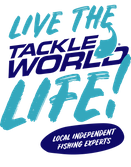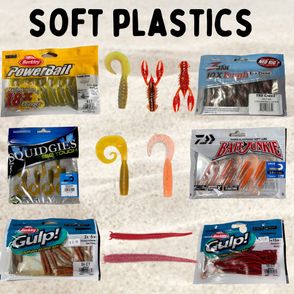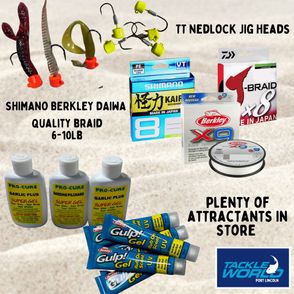King George Whiting on Soft Plastic
Catching King George Whiting on soft plastics
KGW are certainly a more difficult fish to target on anything else but bait but they are not impossible to catch on lures and soft plastics.
I tried using plastics quite a long time ago and caught very little on them and then I just gave up and thought it was just a waste of time and money. After a while and seeing all the new soft plastics on the market and seeing what a few other fishers have caught on soft plastics, I decided that I needed to give plastics another go, so out I went and started to target Whiting first. Bad idea I thought trying for Whiting first given my past experience, but when I gave it go, I couldn’t believe how easy it was and now using plastics for Whiting is my favourite method to catch them.
These days there’s plenty of options out there, there is a huge range of lures and soft plastics on the market and the hard part is selecting what will work for Whiting. In choosing a lure for any fish, you need to understand the fish, we need to know where they live, what they eat, when they eat and when they are going to be there.
The best place to start looking for KGW are sandy areas with some good weed areas for cover where they can hide from predators. There are lots of areas that will fit that criteria and can be at various depths, you can also find them in rocky areas with sand and weed which are also suitable areas to target them.
Food-wise Whiting do have a big diet, feeding on worms, prawns, shrimps, shell-fish, squid and probably small fish as well. KGW are predominantly bottom feeding fish and don’t rise too far off the bottom.
There’s a range of best times to catch KGW and it all varies depending on where you fish, tides, time of year etc. I won’t go into that too much because if you’re reading this there is a fair chance that you are already a proficient Whiting fisher and you would already know where to find Whiting, if you are a beginner then come and have a chat to our staff to get all tips.
Selecting a lure or soft plastic is the harder part as you don’t want to be wasting your money on lures or soft plastic that don’t work. That’s where the Tackle World Port Lincoln crew can steer you in the right direction.
So, for selecting soft plastics it’s best to look closely at what they feed on and try to match the hatch, there’s a big range of soft plastics but there’s only a few selected ranges that work for KGW.
By far the most popular soft plastic for Whiting is Gulp Worms, these now come in a variety of colours and sizes and the most popular one is the 2inch Bloodworm followed by the 2inch Sandworm. There are other colours that also work but these are the two most popular and they also come in a 4inch and 6inch size which can be cut into smaller bite size pieces and can be substituted as bait on paternoster rigs which are used for Whiting.
2.5inch Grubs in Z-Man, Powerbait, Daiwa Bait Junkie and Shimano Bio Tough brands also work and are mostly used for Bream and Flathead but have been proven to work superbly on Whiting. Sometimes it’s best to cut back the body of the grub just to make it smaller and a bit more appetizing for the KGW.
Another soft plastic that are extremely deadly and my favourite are the Jackson Chino Koro Claw and the Z-Man Crawls. These are more closely like a shrimp or salt water yabbie and Whiting absolutely love these. The claws on these soft plastics wave around in the water and when the fish are really on, I have seen the Whiting come right up off the bottom into mid water to take these plastics before their mates have a crack back down on the bottom, something that doesn’t happen often.
These soft plastics are best matched with the TT ned rig jig heads, the orange or chartreuse colour are best, these are bright, stand out and the KGW are attracted to these bright colours. TT ned rig jig heads are shaped much differently than any other jig heads, they are shaped round with a flat bottom and flat head much like a mini round water tank and the hook is designed to be facing upwards. When you rig up a soft plastic on these jig heads they should stand upwards, the worm will stand up, the grub tail will stand up waving around in the water and the yabbie type of soft plastics will have the crawls waving around in the water.
To work these soft plastics, you do need them as close to the bottom as possible. The shallower the water depth the better, between 2-3.5 metres is ideal but you can work these in water to 7 metres, but it all depends on the tide. If the tide is running hard in deeper water, then this would be a waste of time and you’re better off with bait. It’s best to cast as far as you can and let the plastic drift right down to the bottom. I use a slow retrieve as you want the soft plastic right down on the bottom for as long as possible, give the plastic a few twitches and then a couple of winds of the reel. It’s an easy retrieve and shouldn’t take too long to get the hang of it.
Rod and reel setups are different than most other popular Whiting setups. 7-foot rods are the best size rods for this type of fishing. You want a light rod, 2-4kg or nibble tip rods which make for excellent soft plastic rods. Nibble tip rods are my favorite as you get good bite indications when the line is slack. There’s plenty of good quality rods in the Shimano and Daiwa range priced anywhere from $80 up to a Shimano Zodias or Daiwa In-feet which can be priced in the $300 plus range are excellent rods.
For reels a 1000 or 2500 size is all you need, you don’t need a big reel for this type of fishing but you will need 6-10lb braid. You don’t have to spend a lot of money on the reel, I find the rod is where the money should be spent as the rod does most of the work.
Shimano Sienna’s are a great value for money reel under $100 and will be fine for this job. But if you’re after quality both Daiwa and Shimano make some really good reels and there are plenty to choose from in the $100-$350 range which are excellent for this kind of fishing.
Generally Bream and Yellowfin Whiting set-ups are what we use for soft plastic fishing for Whiting.
As mentioned previously 6-10lb braid is preferred for soft plastic fishing for Whiting and good braid is always the way to go. Shimano Kairiki, Berkey X9 and Daiwa J-Braid in the 8 carrier are the best choices to start with, you can go lighter if you wish and if you are going heavier, I wouldn’t go any more than 15lb as braid takes longer to hit the bottom, a fluro carbon leader 10-16lb is also recommended.
I still use a burley pot when using soft plastics as the burley will get the KGW in the feeding mood and make them more interested in soft plastics. Crushed Pilchard burley blocks are the way to go but any other burley types can be used. I also use some of the different catch scent gels to rub onto the soft plastics. Gulp Gel, S Factor and Pro-Cure gels are all worthwhile using and do work but I find the Pro-Cure has plenty of different scents which appeal to Whiting and are the best ones try.
So if you are after a challenge or a different way of catching one of SA’s favorite fish this is a good way of targeting Whiting. It’s not for everyone but for those that can master this form of fishing it’s addictive, exciting and I would say even a cheaper way of fishing for Whiting as soft plastic’s go a long way.
When you head in store you will see we have a dedicated soft plastic KGW section where you will find the best plastics, jig head, braid, leader and a few combos made up for this kind of fishing which is located at the front of the store. This should make it easier for you and the staff are all too happy to have a chat and get you set up and ready to give soft plastics a go.
Shane Hodgens – Tackle World Port Lincoln





